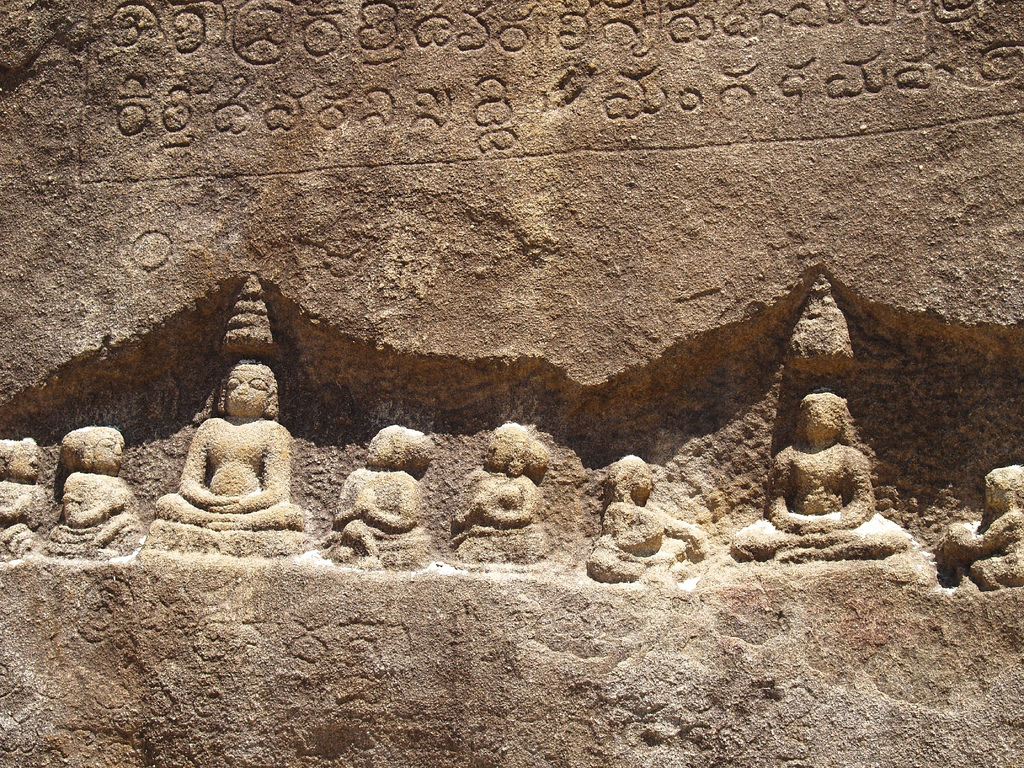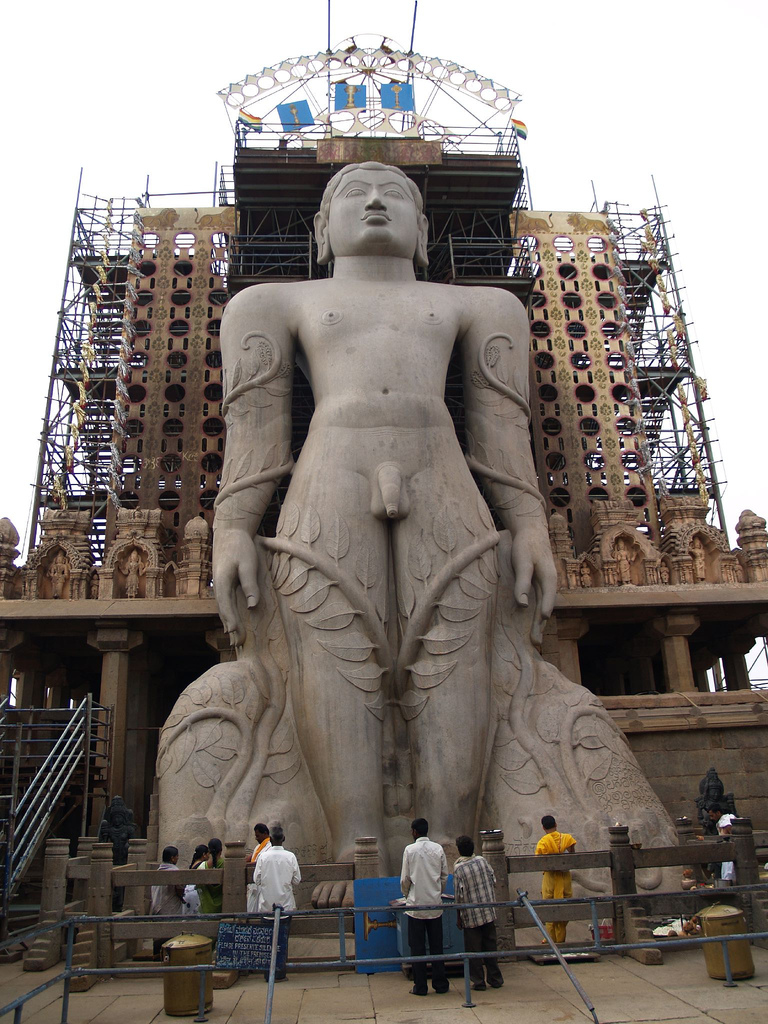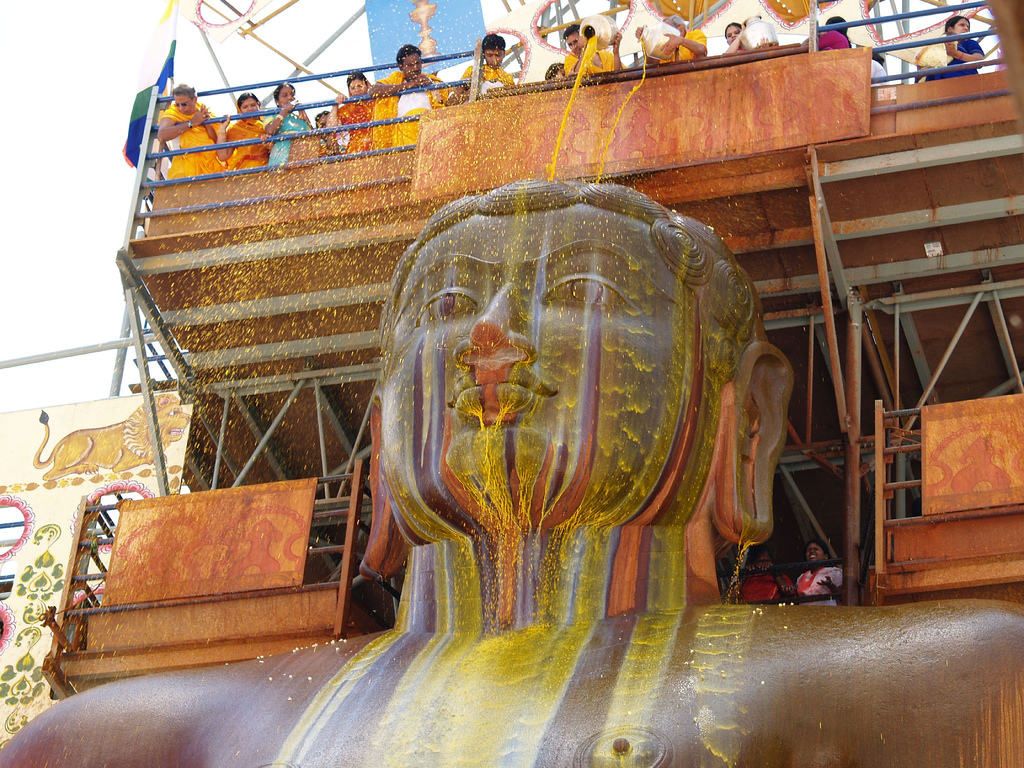Shravanabelgola
is one of the most important Jain tirthas (sacred place of the Jains) in South India and an important place of pilgrimage. The place is famous for the colossal statue of Gommateshvara (dating 978-993 CE) on Indragiri hill.
Shravanabelgola Matha is a seat of Deshiya Gana (also named Deshiya Gana Pustaka Gaccha) of Mula Sangh, headed by the Bhattaraka of Shravanabelgola. At this place the siddhanta-granthas were once preserved before the library were moved to Mudabidri.

Temples of Chandragiri
1. Name
Shravanabelagola or 'the white pond of the Sravana' (i.e. 'the Jain monk') is so named with reference to the colossal Jain image of the place and its prefix Shravana also serves to distinguish it from other Belgolas with the prefixes Hale and Kodi. The derivation of the word Belagola appears to have been from the two Kannada words Bel ('white') and Kola ('pond') in allusion to the beautiful pond in the middle of the town. The Sanskrit equivalents Sveta-sarovara, Dhavala-sarovara and Dhavala-saras used in the inscriptions support the derivation of this word from the two Kannada words. Some inscriptions mention the name of the place as Belgula, Belugula and Belagula, which have given rise to another derivation from the plant, white gulla (Solanum ferox) in allusion to a tradition which says that a pious old woman completely anointed the colossal image with the milk brought by her in a gullakayi or 'gulla fruit'. The place is also designated as Devara Belagola ('Belgola of the God') and Gommatapura ('the city of Gommata', i.e. the name of the colossus) in some epigraphs. Further, the epithet Dakshinakasi or southern Kasi is applied to it in some modern records.
2. History
About eight hundred odd inscriptions which the Karnataka Archeological Department has collected at the place are mostly Jaina and cover a very extended period from 600 to 1830 CE. Some refer even to the remote time of Chandragupta Maurya and also relate the story of the first settlement of Jains at Shravanabelagola. That this village was an acknowledged seat of learning is proved from the fact that a priest from here named Akalanka was in 788 CE summoned to the court of Himasitala at Kanchi where having confuted the Buddhists in public disputation, he was instrumental in gaining their expulsion from the South of India to Ceylon. At the time of the conversion of Vishnivardhana Hoysala to the Vaishanava faith by the reformer Ramanujacharya it is wrongly alleged that the Jains suffered much persecution, but in reality their influence at the court continued practically unabated. Differences between the Jains and Sri Vaishnavas existed, but a compromise was brought about in the time of Bukkaraya of Vijayanagar which resulted in a declaration of toleration which was inscribed on stones and set up in public places.
 |  |
Siddharagundu on Indragiri hill: rock with rows of carved Jina images. | |
3. Town
Shravanabelagola occupies a unique and prominent place as an abode of innumerable Jain temples of Digambara sect in south India since 5th century. In addition to its archeological and religious importance the artistic and antiquarian richness of the place has merited it immensely. As mentioned above, it has derived its name Belagola from two Kannada words Bel means 'white' and Kola means 'pond'. The name Belagola is been found in an inscription of 650 CE and also 800 CE. Hence the word Shravanabelagola means 'the place of white pond' where in Shravanas or Jain ascetics live. It is a picturesque place lying between two rocky hills Indragiri and Chandragiri. It is situated about 13 km from Channarayapatna taluk of Hassan district. Shravanabelagola abounds in inscriptions denoting Ganga, Rashtrakuta, Hoysala, Vijayanagar and Mysore Wodeyars reign of the place. The shrines, canopies, monuments, tanks, nishadi stones, manasthambhas and other relics of the past have incessantly carved the message of Jainism throughout the land from time to time. It has enjoyed both the royal patronage and the common-folk alike. These have been maintained in good state and preserving heritage. Hence it is reckoned as one of the flourishing centre of Jain pilgrimage. Furthermore the historians, art lovers and research scholars are see thronging at the place very frequently. The nearby places such as Kambadahalli Jinanathapura and Halebelagola also bear the testimony as the satellite centers of the religion. The temples are beckoned with cultural niche in terms of tradition of sculpture and architecture. The temples situated on the top of Indragiri and Chandragiri Hills, in the township and around Shravanabelagola narrate the history of the place in a lucid way. These are built mainly out of granite stone available in the place. Whereas the temples constructed during the Hoysala period are mainly soap stone.
4. Chandragiri
The smaller hill known locally as Chikkabetta rises about 175 feet above the plain and is 3,052 ft above the level of the sea. In the old inscriptions it is designated as Katavapra in Sanskrit and as Kalvappu or Kalbappu in Kannada. A portion of this hill is known as Tirthagiri and Rishigiri. With the exception of one shrine, all the basadis on the hill are enclosed in a walled fort area. Almost all the temples are built in the Dravidian style of architecture, the oldest of them going back probably to the eighth century CE. Altogether the number of the temples in the walled fort area is fourteen and their plans are mostly similar to one another. The history of this hillock dates back to 2nd century BCE and has a history that is 1000 years older than that of Indragiri. We can find many inscriptions spread across the hillock. These inscriptions help us understand the antiquity of Jainism and Shravanabelagola.
 |  |
Colossal statue of Gommateshvara on Indragiri visited by pilgrims (left) and during Mahamastakabhisheka (right) | |
5. Indragiri
The larger hill known as Indragiri or Doddabetta rises about 470 feet above the plain at its foot and is 3,347 feet above the sea level. It is ovoid in shape, its long diameter being perhaps a quarter of a mile. It is also sometimes designated Vindhyagiri. A flight of about 800 steps cut in the granite rock leads up to the summit. The entire area of the Vindhyagiri hill has been divided into two parts by a heavy wall at some distance around The antiquities are described in this section in the order in which they occur as one goes up the hill.